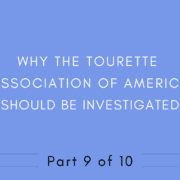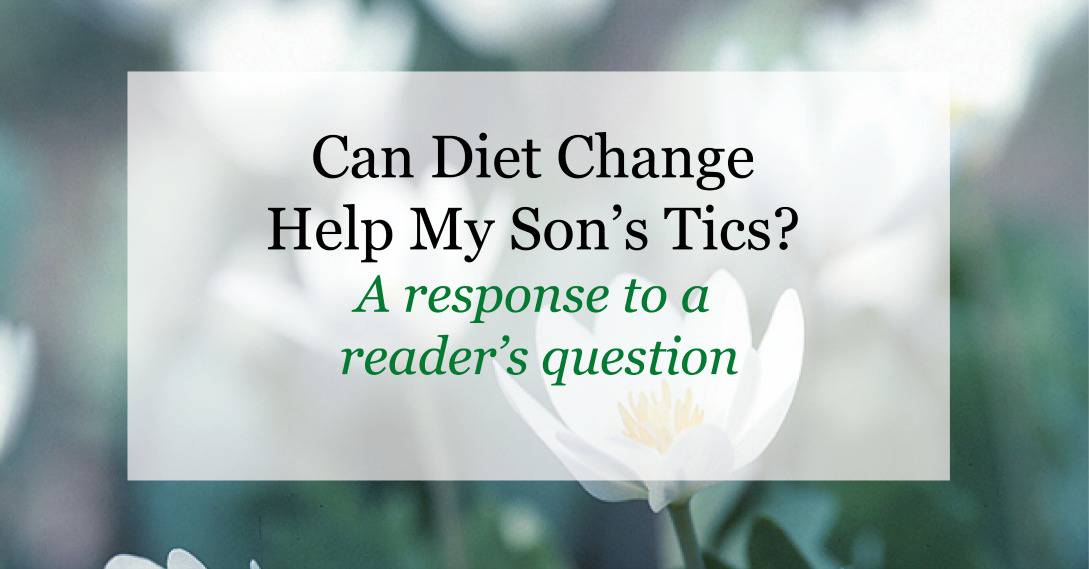Tourette Syndrome and Food Reactions: Seeing is Believing
My 12-year-old daughter, Lisa, suffered from a terrible and traumatic case of Tourette syndrome. We were finally able to help her this past school year, with no thanks to her doctors.
The early years
It was a difficult pregnancy, due in part to my own health issues. Lisa was born post-term. Unfortunately, I could not breastfeed, and she had trouble tolerating formulas. Standard Enfamil formula made her vomit; Parent’s Choice brand made her so lethargic that one day we had to rush her to the emergency room; she seemed almost catatonic. She was finally switched to Nutramagin, a non-milk formula from Enfamil. Lisa’s response was better, though not ideal.
As a toddler, she was a picky eater but seemed to do fine overall, and no other food allergies were detected. But she did have all kinds of allergies to other things, especially chemicals and perfumed items. As an example, the only laundry detergent I could use was All brand “Free and Clear.” Dryer sheets, fabric softeners, and bleach in the laundry caused an immediate itchy rash all over.
Tics begin at age 10
Lisa has a physical problem that makes her prone to urinary tract infections, so she has taken many rounds of antibiotics. She also suffered from chronic nasal strep infections. For a separate issue, a doctor prescribed premarin cream, and despite assurances it was safe, she had a shocking and abrupt entry into puberty. Needless to say, this was upsetting for a young girl to deal with. When her tics started up, it was the last thing she needed.
The tics began with just a small amount of finger-rolling when she spoke to us. Like an excited child, she would hold her arms up and roll the thumb into the fingers. Then, last year, a mouth grimacing movement developed.
I asked the doctors about all her health issues and whether they could be playing a role in her tics: the sensitivities, antibiotics, hormones, and strep. I was told we just needed to accept the fact that she had Tourette’s and that it was probably genetic. Yet I checked with our extended family, and there was no sign of Tourette’s or anything like it.
The nightmare of sixth grade
Last year at age 11, Lisa entered middle school, and the stress was tremendous—new staff and students plus a new routine. Her mannerisms had been accepted or overlooked at her previous school, but she was now subjected to consequences from her teachers for “fidgeting.” Vocal tics began.
The teachers were judgmental, and the students were cruel with their taunts. The staff insisted Marcy had ADHD. I’m a former degreed social worker and was a foster parent for twelve years; I’ve seen my share of ADD and ADHD! The fact was, she had no hyper behavior at all and was an A student. After being summoned to many meetings by the school, I discovered it was really the “tics” they didn’t like. They wanted her medicated—now! We tried Tenex, but it did nothing to help and made her zonked out and sleepy. After two weeks I discontinued it, with her physician’s approval.
Then, within a two-week span, we saw tics emerge at a frightening pace. Most tics were new ones we had never seen. Previously, only one tic had appeared at a time, and now there were four or five at once. She would cry because her shoulder hurt from the relentless arm jerking. She complained of joint pain from moving her legs so much.
My family insisted Lisa was doing it on purpose, but we saw her tic even when she was sound asleep. The teachers insisted it was on purpose as well. I tried to explain, but they wouldn’t listen. This was devastating for her.
Soon Lisa’s head began moving, and she started blinking, along with the other movements. Meanwhile, the vocal tics kept increasing. She made a sniffing sound and little animal-like sounds, like a guinea pig. We couldn’t understand the rapid increase in tics, and it was frightening.
Tracking down the culprits
At this point, my mother asked whether there might be a connection with our recent weight-loss diets. We were on a diet—both Lisa and I are overweight. At first I assured her there couldn’t be a link, because one thing we did on this new diet was get rid of junk food. It seemed that was a good idea! But when my mother asked what we had replaced the junk food with, I realized something.
My family had all started on a health-conscious diet together, and Lisa lost ten pounds. We were keeping food diaries, watching “The Biggest Loser” on television, and exercising. The TV show had stressed the healthy addition to the diet of Yoplait Light fat-free yogurt.
At only 100 calories, it was a treat for her in place of the sweets she used to enjoy. I also remembered that our daughter was now consuming no-calorie drinks made with tubes of powdered mix added to bottled water. One was “Crystal Light,” and there were other brands.
I went to the cabinet and read the ingredients on these drink powders. There it was: aspartame. It was also in the so-called healthy yogurt! I called the pediatrician to report this discovery and was told once more that I simply needed to accept her condition more fully. I kept pressing the issue, so finally the doctor conceded that if I was so concerned, I should pull them from the diet and see if it helped
We did. I took care to remove all products that had any amount of aspartame, under any of the marketing names used for it: NutraSweet, Equal, Spoonful, Benevia, NutraTaste, and the most recent term (presumably intended to fool consumers and avoid the bad reputation of aspartame/NutraSweet): AminoSweet. (Editor: They were also eliminating food dyes by doing this.)
The effect was astounding. All tics decreased dramatically. Most stopped completely, and the verbal ones simply disappeared.
I began to think about how my daughter has always been affected by chemicals on the outside of her body. She can’t use most shampoos or bath products and has never been able to tolerate even bubble bath. If those chemicals affected her so much externally, didn’t it make sense that chemicals could be causing her problems internally?
Taking action
When I thought about her doctor, I was angry! The possibility of food allergies was completely sound and logical thinking, but they belittled this theory at the clinic. The medication was not only ineffective, but I worried about the risk of her developing tardive dyskensia, among other side effects. Meanwhile, my daughter suffered physically, academically, and emotionally.
I began to watch which foods did or didn’t affect her. After thirty days of no artificial sweeteners, I deliberately added aspartame to her diet, and immediately the tics came back, as bad as before. Then I removed it, and they went away as before.
I am no physician, but I’m not an idiot, either. I saw a vast change, like the flip of switch. By keeping a food journal and making careful observations, I found other foods that trigger her tics. Chocolate and sweets are among the top ones, and Lisa seems to crave them all the time. Sugary boxed cereals also trigger an outburst of tics. I’ve noticed that she has food-related mood swings. Previously we were told it was “just puberty” or “PMS.” Now I know better. Of course, fatigue and stress also have an effect.
Aside from causing tics, troublesome foods can make her agitated. We now have an “avoid these foods” list. Artificial sweeteners remain one of the worst. Even one diet soda can send her spiraling back to the severe tic stage.
I actually believe this is a case of undiagnosed food allergy, or what I have dubbed “food toxicity.” I believe my daughter was born with a sensitivity to many substances, some yet unknown to us. She is simply unable to handle the many unhealthy food additives in our food supply.
I was so happy to find your ACN Latitudes site, where so much information is available free of charge. I am going to look into yeast (candida) to see if that is something we need to consider.
I apologize that my letter is so long, but I wanted to give a clear and accurate view of what occurred, how quickly things escalated, and how important it was for us to start listening to our child and use common sense. Trial and error, watching, and keeping records were so important. What we believed was happening was sound and logical, and we had to persevere when the doctors ridiculed us. This will be an ongoing and uphill climb at times, but her tics are now hardly noticeable.
By the way, we set up her up with an IEP (individual educational plan) so the school staff could no longer penalize her for “fidgeting.” And I am happy to report that by the end of sixth grade, her grades were back up, with all A’s and B’s.
Yoplait Light Fat-Free ingredients at time of writing
Cultured Pasteurized Grade A Nonfat Milk, High Fructose Corn Syrup, Modified Corn Starch, Nonfat Milk, Kosher Gelatin, Aspartame,* Natural And Artificial Flavor, Potassium Sorbate Added To Maintain Freshness, Citric Acid, Red #40, Yellow #6, Vitamin A Acetate, Blue #1, Vitamin D3. *Phenylketonurics: Contains Phenylalanine.
Crystal Light Raspberry Lemonade On the Go ingredients at time of writing
Citric acid, potassium citrate, calcium phosphate, aspartame, raspberry juice solids, contains less than 2% of natural and artificial flavor, acesulfame potassium, soy lecithin, artificial color, Red 40, Blue 1, tocopherol for freshness.
Name is withheld at the request of the family.










Thank you for sharing this story. How long does it take for the tics to stop once you discontinue a trigger food? Thanks.